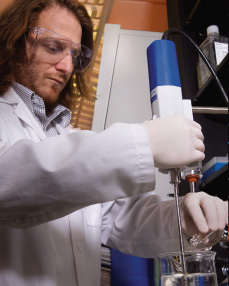The Right Recipe

By Kay Torrance | Illustration by Carol Hatcher
A new microparticle-drug combination may be key to reducing inflammation caused by heart attack and other diseases
Researchers believe that a number of anti-inflammatory drugs, if delivered directly into the heart following heart attack, could prevent permanent damage and prolong heart function. The challenge, however, is finding an effective way to deliver the drugs. Some drugs require such large doses that toxicity becomes a risk. Others must be injected daily. Certain drug delivery methods themselves can cause inflammation.
An Emory research team believes it has found the right recipe of ingredients to one day make safe, effective drug-laden microparticles for heart attack patients.
The team, led by biomedical engineer Michael E. Davis, found that injecting animal hearts with microparticles formulated with the polymer PCADK—poly(cyclohexane-1,4-diylacetone dimethylene ketone)—improved cardiac function after simulated heart attack. Unlike other “carrier” molecules, PCADK degrades into two benign substances: 1,4-cyclohexanedimethanol, an FDA-approved food additive, and acetone, an endogenous compound.

After simulating heart attack in rats,
biomedical engineer Michael E. Davis
found that injecting their hearts with
microparticles containing a p38 inhibitor
drug reduced formation of scar tissue
by 70% to 80% and improved heart
function by at least 20%.
Inside the polymer beads was an experimental drug, SB239063, a p38 inhibitor. P38 is a protein kinase that regulates the production of inflammatory mediators. It also plays a role in the death of myocardial cells. The polymer bead containing the drug stayed in the heart and slowly dissolved, allowing sustained release of the drug to suppress p38 activation for at least seven days. An injection of just the drug didn’t work though; it likely diffused away too quickly.
“The drug releases at a rate that is dependent on the breakdown of the particle,” says Davis. “As the particles break down and are hydrolyzed, the drug is released. In our study, half of the drug was released in about seven to 10 days.”
In contrast, the team also tested another carrier molecule, a glycolic acid known as PLGA. PLGA broke down into lactic acid and caused an increase in p38.
“Since PLGA is a standard for drug delivery and one of the only clinically approved polymers, we used that target,” says Davis. “But there’s a reason why it’s not used for heart disease. Anyone who has run or worked out too much can tell you how bad lactic acid is. It hurts. These PLGA particles degrade into lactic acid, which is not good when you already have an inflammatory response resulting from heart failure. That’s the big difference in this study—neutral degradation products versus acidic degradation products.”
When Davis and his team looked at heart function in rats injected with the PCADK beads seven days after induced heart attack, they found no real improvement. Three weeks later, however, heart function had significantly improved.
“We think this difference is explained in that myocardial infarction causes significant damage in the first 24 to 48 hours,” Davis says. “The half-life of our particle is about seven days, so it is likely that the inhibitor was not released fast enough to affect heart function at the seven-day mark.” Overall, the microparticles reduced formation of scar tissue by 70% to 80% and improved heart function by at least 20%.
Microparticles have had limited use in the treatment of inflammatory disease because traditional delivery methods and their by-products caused the very thing they were supposed to limit—inflammation. Davis and his team found that PLGA (a polyester approved for use in sutures and grafts) did cause inflammation, but that PCADK did not. “PCADK has the potential to be used to deliver other kinds of anti-inflammatory drugs for other diseases,” says Davis, whose study results were published in nature materials (October/
November 2008). In the future, he hopes the microparticle-drug combination could be used clinically to treat diseases of the liver, lungs, and spinal cord as well as the heart.


